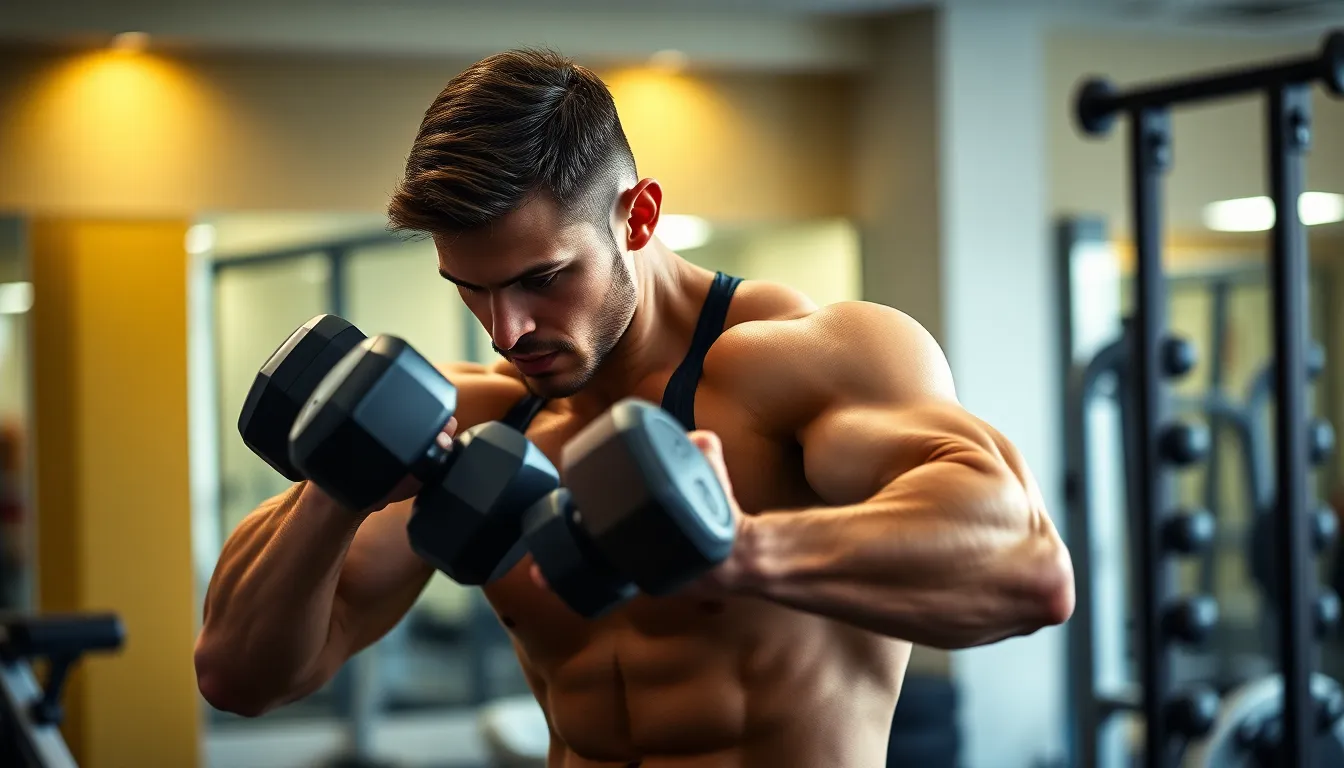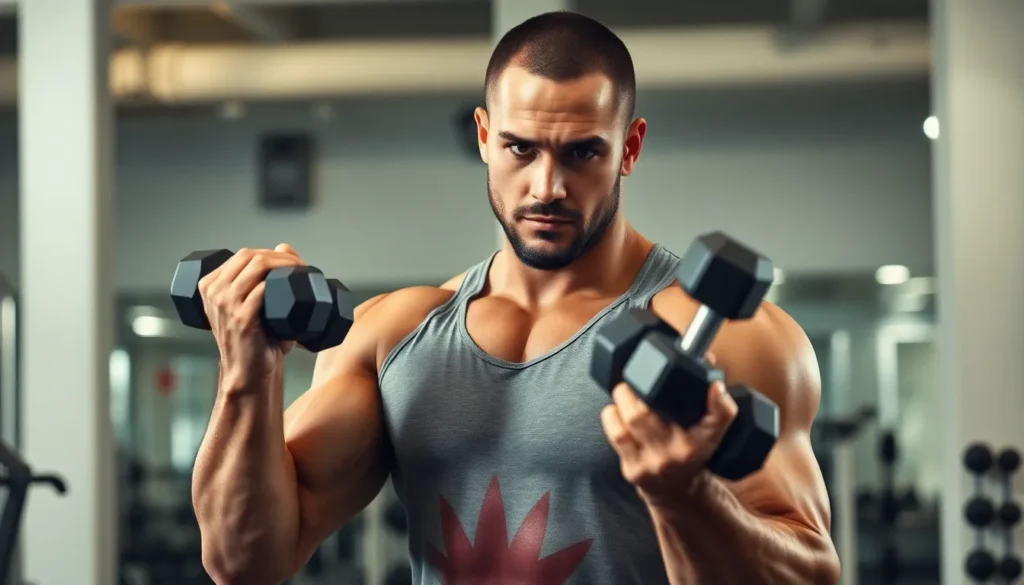Hammer curls are a popular exercise that pack a punch when it comes to building arm strength. Unlike traditional bicep curls, this variation targets multiple muscle groups, making it a powerhouse for anyone looking to enhance their upper body workout. With a unique grip that mimics the motion of using a hammer, this exercise not only works the biceps but also engages the brachialis and brachioradialis, key muscles in the forearm.
Incorporating hammer curls into a fitness routine can lead to improved grip strength and overall arm definition. Whether you’re a seasoned lifter or just starting out, understanding what hammer curls target can help maximize your workout and achieve your fitness goals. Dive into the specifics of this exercise and discover how it can elevate your strength training regimen.
Table of Contents
ToggleUnderstanding Hammer Curls
Hammer curls effectively target various muscle groups in the arms and forearms. This exercise builds strength and improves the overall appearance of the upper body.
Definition of Hammer Curls
Hammer curls consist of a bicep curl performed with a neutral grip, where the palms face each other throughout the movement. This grip engages the biceps brachii, brachialis, and brachioradialis, emphasizing brachial development and enhancing forearm stability. The exercise involves flexing the elbows while maintaining straight wrists, which helps improve functional strength.
Common Variations
Several common variations of hammer curls exist that target muscles differently or provide unique challenges:
- Dumbbell Hammer Curls: Utilize dumbbells to perform the exercise, focusing on individual muscle engagement.
- Cable Hammer Curls: Use a cable machine with a rope attachment, allowing for constant tension during the movement.
- Cross-Body Hammer Curls: Raise the dumbbell in a diagonal path across the body, targeting the shoulder muscles in addition to the arms.
- Zottman Curls: Combine a hammer curl with a reverse curl, which targets biceps and forearms uniquely throughout the range of motion.
- Resistance Band Hammer Curls: Use resistance bands to add variable resistance, promoting stability and muscle engagement through different tension levels.
Incorporating these variations into a workout routine can enhance strength training and prevent workout monotony.
Muscles Targeted by Hammer Curls

Hammer curls effectively target several key muscles in the arms, enhancing overall strength and definition. The neutral grip used during this exercise ensures a balanced engagement of various muscle groups.
Biceps Brachii
Biceps brachii primarily consists of two heads: the long head and the short head. Hammer curls activate both heads, promoting hypertrophy and strength. Strengthening the biceps through this exercise contributes to improved pulling power and functional movements in daily activities.
Brachialis Muscles
Brachialis muscles lie beneath the biceps. Hammer curls significantly engage brachialis muscles, making them critical for overall arm development. Strengthening the brachialis adds definition to the upper arms and enhances the biceps’ appearance, creating a fuller look.
Brachioradialis
Brachioradialis is a key forearm muscle involved in elbow flexion. Hammer curls emphasize brachioradialis due to the neutral grip position, which challenges this muscle effectively. Strengthening the brachioradialis aids in grip strength and improves performance in various upper body exercises.
Benefits of Hammer Curls
Hammer curls offer multiple benefits, particularly in arm strength and functional movement. Incorporating this exercise into a fitness routine promotes continuous improvement.
Strength Development
Strength development occurs primarily in the biceps, brachialis, and brachioradialis muscles. Hammer curls build muscle mass effectively due to the exercise’s engaging nature. The brachialis, situated beneath the biceps brachii, plays a critical role in overall arm growth. Strength gains in these muscles translate to improved performance in various upper body exercises and daily activities.
Joint Stability
Joint stability benefits significantly from hammer curls, particularly in the elbows and wrists. The neutral grip position minimizes stress on the joints, enhancing stability during movement. Strengthening the brachioradialis contributes to better control and coordination of arm movements, which reduces injury risk while lifting objects or performing complex workouts. Improved joint stability fosters overall fitness progress and supports sustained engagement in strength training.
How to Properly Perform Hammer Curls
Performing hammer curls properly ensures maximum effectiveness and minimizes injury risk. Focusing on technique is vital for targeting the intended muscle groups efficiently.
Technique Tips
- Stance: Stand upright with feet shoulder-width apart. This position provides stability during the movement.
- Grip: Hold a dumbbell in each hand, palms facing each other. This neutral grip activates the targeted muscles effectively.
- Elbow Position: Keep elbows tucked close to the torso throughout the exercise. This placement prevents unnecessary strain on the shoulders.
- Movement: Curl the dumbbells upward while maintaining the neutral grip. Focus on lifting through the biceps, brachialis, and brachioradialis.
- Breathing: Exhale during the upward movement and inhale while lowering the weights. This breathing pattern supports exertion and control.
Common Mistakes to Avoid
- Swinging Weights: Avoid using momentum to lift the weights. This practice reduces effectiveness and increases the risk of injury.
- Overextending Elbows: Do not lock the elbows at the bottom of the movement. This action can place excessive stress on the joint.
- Incorrect Grip: Ensure the palms face each other. A supinated grip can shift focus away from the targeted muscles.
- Lifting Too Heavy: Don’t choose weights that compromise form. Selecting manageable weights enhances control and muscle engagement.
- Lack of Focus: Avoid distractions during the exercise. Concentrating on each repetition maximizes muscle activation and benefits.
Hammer curls are a powerful addition to any strength training routine. By targeting the biceps brachii, brachialis, and brachioradialis, they not only enhance arm strength but also improve grip and functional movement. Incorporating variations of hammer curls can keep workouts fresh while challenging different muscle groups.
Proper form and technique are essential to maximize benefits and minimize injury risk. With consistent practice, individuals can expect to see significant improvements in arm definition and overall strength. Embracing hammer curls can lead to better performance in both gym workouts and daily activities, making them a valuable exercise for anyone looking to boost their fitness journey.



